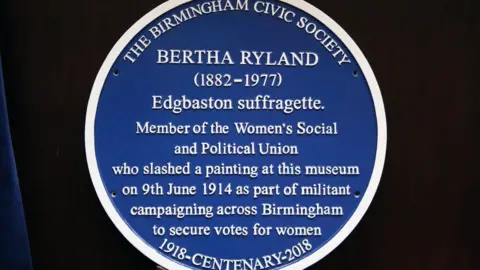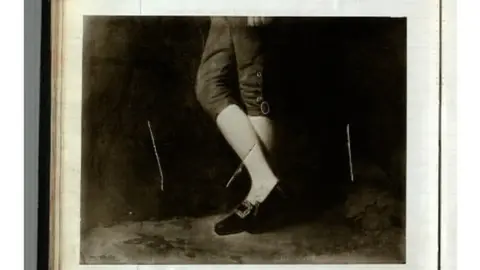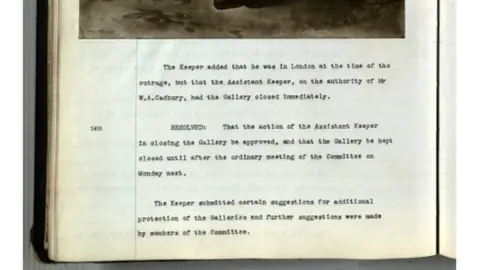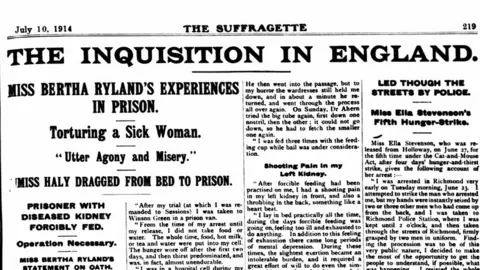Blue plaque for Birmingham 'painting attack' suffragette
 Birmingham Museum and Art Gallery
Birmingham Museum and Art GalleryA blue plaque is being unveiled to mark the moment a suffragette slashed a painting with a meat cleaver.
But who was Bertha Ryland, the woman who carried out what could be seen today as a "domestic act of terrorism" and left a note behind to make sure her voice was heard?
A wealthy and intelligent young woman and a member of the respectable "Edgbaston elite" in Birmingham, Ms Ryland did not arouse suspicion when she entered the gallery with her "chopper" concealed under her coat in the middle of the afternoon of 9 June, 1914.
It was exactly a year and a day since Emily Wilding Davison died as a result of the injuries she sustained at the Epsom Derby.
Slashing the canvas three times, Ms Ryland caused £50 worth of damage to the painting known as Master Thornhill, by 18th Century artist George Romney.
It led to Birmingham Art Gallery being closed for six weeks, according to University of Birmingham research fellow Dr Nicola Gauld.
 Library of Birmingham
Library of Birmingham Library of Birmingham
Library of BirminghamIn a note left at the scene, Ms Ryland said her actions were a deliberate protest "against the government's criminal injustice in denying women the vote" and "against the government's brutal injustice in imprisoning, forcibly feeding and drugging suffragist militants".
It was not the first time the suffragette had made her views known.
She served six months in Holloway prison in 1912 for her involvement in a London window-smashing campaign where she was force-fed after refusing to eat.
 Google
GoogleWhen she appeared before magistrates following her arrest at the Birmingham gallery, she refused to go along with proceedings and was taken to Winson Green Prison ahead of her trial.
She, like many other suffragettes, went on hunger strike and was force-fed again.
Hilda Burkitt, the first suffragette to undergo the "inhumane" practice spoke out against force-feeding while Ms Ryland later described it as a "unutterably hideous experience".
Writing in The Suffragette Newspaper in July 1914, Ms Ryland said she underwent the "torture" nine times in 1912 despite having a diseased kidney which had been displaced for years. Force-feeding exacerbated her condition.
"This mauling of the unprotected kidney, together with the retching and choking, strained and twisted the kidney and caused chronic inflammation", she wrote.
 The British Newspaper Archive
The British Newspaper ArchiveShe said she had been "strip searched" and force-fed a further five times.
Eventually, her deteriorating health led to her trial being postponed and the charges against her were dropped in September 1914.
Ms Ryland was born in 1882 and lived in Hermitage Road in Edgbaston. The youngest of five children, she was an active member of the The Women's Social and Political Union (WSPU) between 1907 and 1914. She never married nor had children and she died in the 1970s.
 Birmingham Museum and Art Gallery
Birmingham Museum and Art GalleryThe painting she attacked is on display at the Museum of Fine Arts in Boston, Dr Gauld said.
"There is no label on the artwork or anything that hints to its radical past, though the damage is still visible if you look at the painting closely", she added.
Lynsey Rutter, of the gallery, said it is not encouraging people to follow in Bertha's footsteps, but does want people to understand her intentions.
"What could be seen as an act of domestic terrorism was bringing to the public's attention the lack of equality women were experiencing," she said.
"We have so many platforms now in which we can make a stand. But for Bertha and women like her, those platforms were just not available. So she made sure her voice was heard in whatever way she could."
*The plaque acknowledging Ms Ryland's actions is unveiled on Friday in the art gallery's Round Room as part of the its Women Power Protest project.
